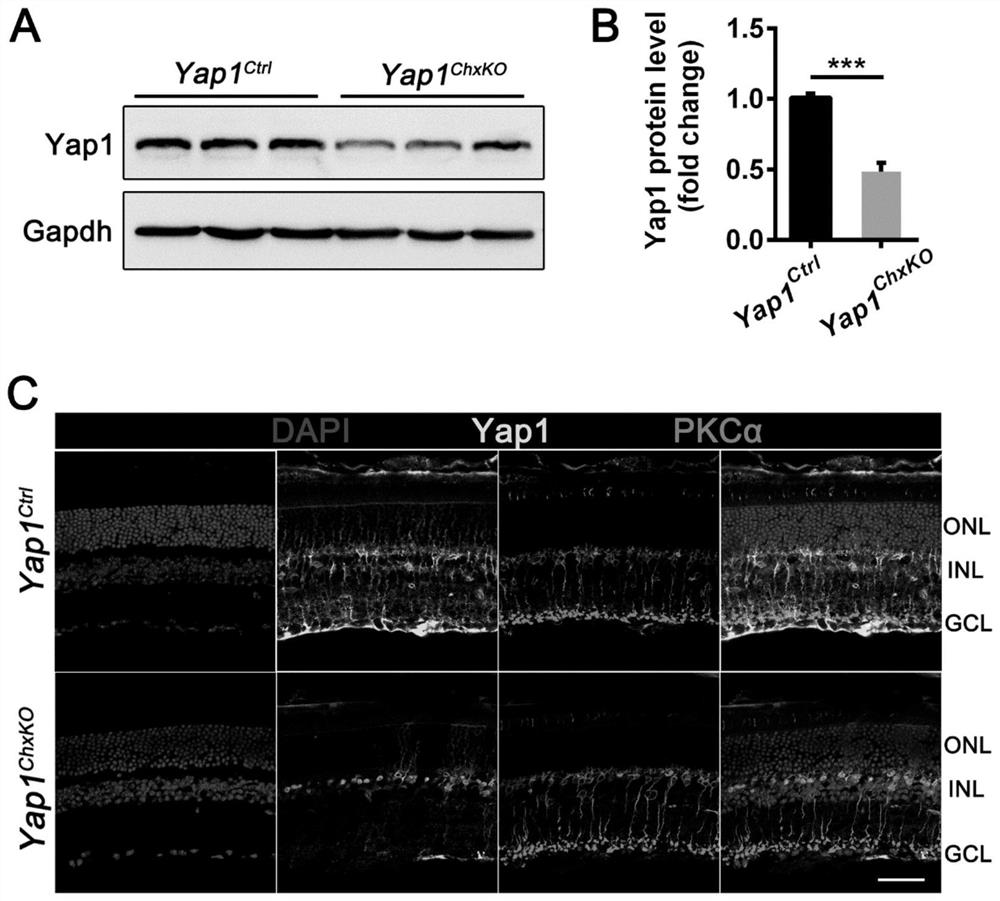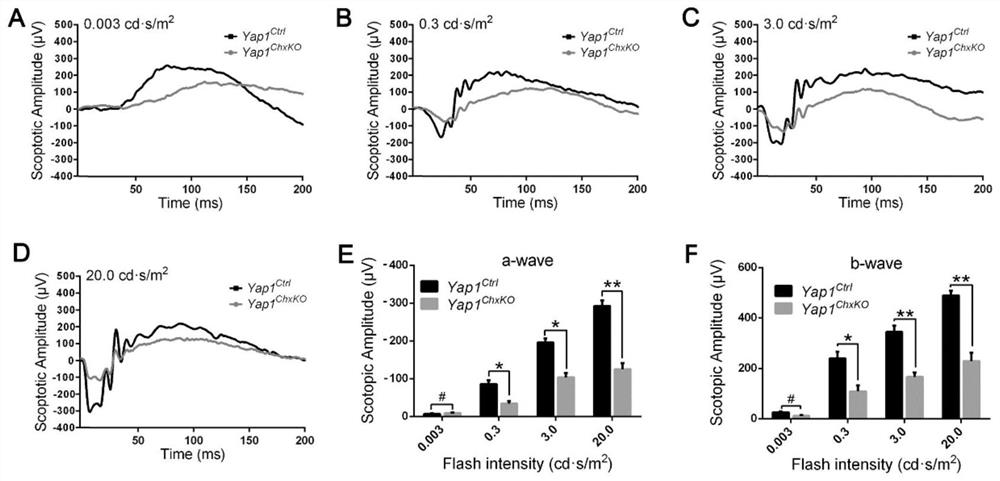Construction method of retina bipolar cytopathy model and application thereof
A bipolar cell and construction method technology, applied in the field of medical engineering, can solve problems such as blindness, obstacles to clinical diagnosis and treatment of diseases, affecting the visual transmission function of bipolar cells, etc., and achieve the effect of broad application prospects.
- Summary
- Abstract
- Description
- Claims
- Application Information
AI Technical Summary
Problems solved by technology
Method used
Image
Examples
Embodiment 1
[0043] This embodiment provides a method for constructing a retinal bipolar cell lesion model. In this example, mouse is used as the target animal, and the method for constructing the retinal bipolar cell lesion model provided by the present invention is described, and the route of Yap1 gene knockout is referred to figure 1 As shown, the specific operation is as follows:
[0044] 1) Obtain the first mouse with knockout of Yap1 gene, the knockout mouse has loxP sites arranged in the same direction at both ends of exon 1-2 of Yap1 gene;
[0045] 2) mating and breeding the first knockout mice obtained in step 1) with wild-type mice, and screening out the heterozygous mice for Yap1 gene knockout in the offspring;
[0046] 3) mating and breeding the Yap1 gene conditional knockout heterozygous mice obtained in step 2) to obtain Yap1 gene conditional knockout homozygous mice;
[0047] 4) The Yap1 gene conditional knockout homozygous animal obtained in step 3) is mated with the Chx1...
Embodiment 2
[0070] Immunohistochemical (IHC) assay was used to analyze the gene knockout efficiency in the retina of Chx10-Cre knockout mice.
[0071] Immunostaining of retinal frozen sections: Take 3-month-old retinal bipolar cell-specific knockout Yap1 mice constructed in Example 1, kill them by neck dislocation, quickly remove eyeballs, put them in 4% PFA, and fix them on ice for 15 minutes Finally, an incision was made on the cornea, and the fixation on ice continued. After 2 hours, the eyeballs were rinsed with PBS buffer for 3 times, and then dehydrated in 30% sucrose solution for 2 hours. Then, the cornea and crystals were cut off under a dissecting microscope, embedded in OCT and quickly placed in a -80°C refrigerator for freezing. After about 10 minutes, the OCT-embedded eyeballs were taken out, placed in a cryostat at -25°C for about 30 minutes, and sliced. The slice thickness was 12 μm.
[0072] After slicing, select a high-quality slice and place it in a 37°C oven for 30 min...
Embodiment 3
[0087] Carry out ERG visual acuity detection to the Yap1 gene knockout mouse of embodiment 1 of 12 months old:
[0088] 1) Dark-adapted animals should be dark-adapted all night, and the environment should be absolutely dark;
[0089] 2) Anesthesia the next day: weighing, intraperitoneal injection; deep anesthesia is appropriate;
[0090] 3) Animal immobilization and mydriasis: After the anesthesia is completed, fix the mouse with adhesive tape in front of the animal test platform under dark red light illumination: it is necessary to ensure that the mouse is "lying", that is, relative to the stimulation port of the flash stimulator, The eyes are at the same height, fully exposed, and mydriatics are added.
[0091] 4) Electrode installation: After preheating the electroretinograph (Espion Visual Electrophysiology System, Diagnosys LLC, Lit-tleton, MA, USA), apply conductive paste to the electrode, clamp the tail of the mouse, and insert it into the "ground" interface of the ampli...
PUM
 Login to View More
Login to View More Abstract
Description
Claims
Application Information
 Login to View More
Login to View More - R&D
- Intellectual Property
- Life Sciences
- Materials
- Tech Scout
- Unparalleled Data Quality
- Higher Quality Content
- 60% Fewer Hallucinations
Browse by: Latest US Patents, China's latest patents, Technical Efficacy Thesaurus, Application Domain, Technology Topic, Popular Technical Reports.
© 2025 PatSnap. All rights reserved.Legal|Privacy policy|Modern Slavery Act Transparency Statement|Sitemap|About US| Contact US: help@patsnap.com



